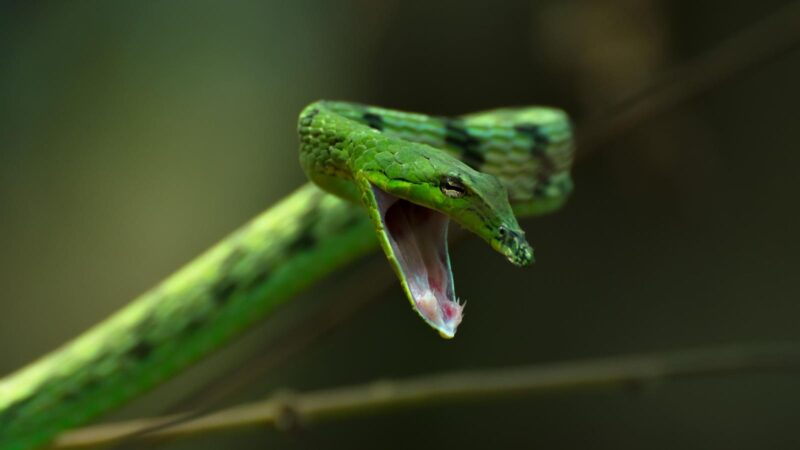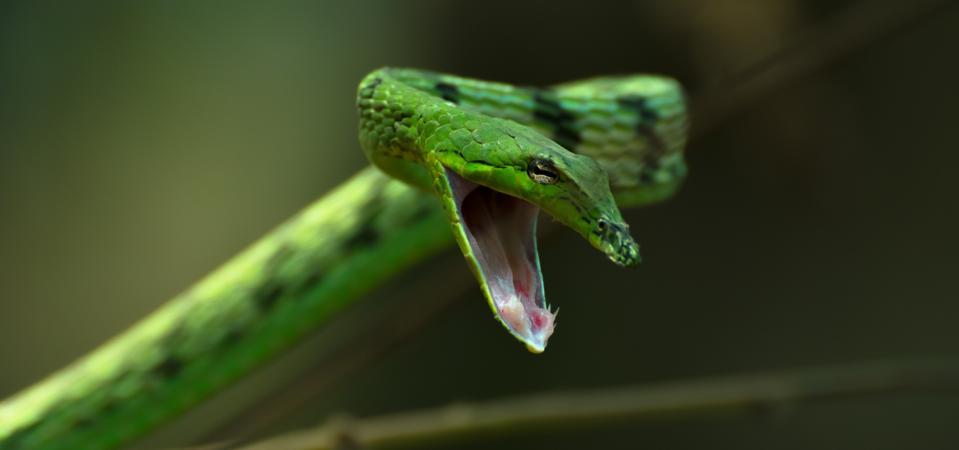Just because an animal is venomous doesn’t always mean it is “un-pettable.” Here are a couple of noteworthy exceptions.
getty
To most people, the term “venomous reptile” evokes images of cobras flaring their hoods or rattlesnakes coiled to strike. It’s a term often used interchangeably with “deadly;” a semantic shortcut that ignores the complex biology behind venom and how it varies widely across species.
But in herpetology, venom is a much broader concept. Not all venomous reptiles are dangerous to humans. In fact, some are kept as pets by hobbyists and pose little to no health risk at all. These are reptiles that use venom as an evolutionary tool for subduing prey, not for self-defense against large mammals like us.
Two reptiles — both technically venomous — that are commonly and safely kept as pets are the Asian vine snakes (genus Ahaetulla) and the North American hognose snakes (genus Heterodon). Neither of these animals poses a serious medical threat to humans, and both provide insights into the spectrum of venom systems in reptiles.
1. The Asian Vine Snake
With its vivid green body and needle-thin frame, the Asian vine snake blends seamlessly into its leafy surroundings.
getty
Sleek, slender and bright green, the Asian vine snake looks like it belongs in a sci-fi movie. Native to the forests of South and Southeast Asia, the genus Ahaetulla is a group of arboreal species well-known for their needle-thin body, horizontal pupils and camouflage capabilities.
It’s a rear-fanged snake, which means its venom-injecting teeth are situated at the back of its jaw, and it mostly feeds on small reptiles and amphibians.
By technical definition, the Asian vine snake is mildly venomous. It secretes a venom that is effective at immobilizing prey, but not harmful to humans. Most bites cause no more than modest localized swelling or tingling, and even those symptoms are uncommon. The snake’s rear-fanged anatomy inhibits venom delivery in significant amounts during bites on human beings that may happen by accident.
Biologically, this snake provides a beautiful example of venom specialization. Its venom has been found to contain proteolytic enzymes and neurotoxins that are suited to act particularly on ectothermic (cold-blooded) prey’s nervous systems. It is essentially a precision tool developed for a specialized ecological niche, rather than a generalized defense weapon.
Captive Asian vine snakes are sought after by intermediate and advanced reptile hobbyists. They need vertically oriented enclosures with ample climbing opportunities, high humidity and suitable UV lighting. Their diet is primarily live lizards, though some hobbyists successfully convert them to feed on frogs, fish or birds.
While it is care-intensive, the snake is legal in most jurisdictions and is appreciated for both its showy looks and lack of high-risk venom. It’s an excellent demonstration of the fact that not all animals that are venomous pose a threat, and that insight into the complexities of venom biology promotes improved husbandry and appreciation of the animal.
2. The Western Hognose Snake
The western hognose snake is best known for its upturned snout.
getty
At first, the western hognose snake (Heterodon nasicus) resembles a cartoon character more than a venomous reptile. A North American native, this short, thick-bodied colubrid has a snout raised at the front for burrowing and a humorously melodramatic defense mechanism: it flattens out its neck, lets out a fierce hiss and even “plays dead” if threatened.
What many don’t know is that the western hognose snake is also technically mildly venomous. Like the vine snake, it is rear-fanged (opisthoglyphous), and its venom is used to subdue small prey, primarily amphibians.
In terms of human interaction, however, this venom is harmless to most people. Bites are rare and generally occur only if the snake mistakes a finger for food. When they do happen, symptoms might include mild swelling or itching, particularly in individuals who are sensitive or allergic.
The venom itself contains enzymes that break down tissue, which is useful when digesting frogs or toads, but the delivery system is inefficient for envenoming anything much larger. In essence, this species poses less risk than a cat scratch in most cases.
From a behavioral standpoint, hognose snakes are a herpetologist’s delight. Their dramatic bluffing behavior is more bark than bite, and they’re known for being tolerant of handling once accustomed to human presence. They’re also relatively easy to care for: they thrive in moderate humidity, don’t require UV lighting and feed readily on frozen-thawed rodents.
The Western hognose snake has become a staple in the pet reptile community, thanks to its manageable size (typically under 3 feet), docile temperament and wide array of morphs (color and pattern variations) produced through captive breeding. It’s a perfect example of how a mildly venomous reptile can be both low-risk and highly rewarding to care for.
Why Mild Venom Doesn’t Mean ‘Dangerous’
It’s important to understand that venom is a tool, not a moral label. Evolution has produced venom in reptiles for various reasons: to immobilize prey, begin the digestion process or to deter predators. But the potency and purpose of venom varies dramatically across species.
In the cases of the Asian vine snake and the hognose snake, venom serves a specific ecological role and poses virtually no danger to humans. These reptiles demonstrate how broad the term “venomous” really is and why it shouldn’t automatically trigger alarm (though it’s always best to err on the side of caution).
As always, keeping any reptile — venomous or not — requires knowledge, commitment and respect for the animal’s biology.
Are you an animal lover who owns a pet? Take the science-backed Pet Personality Test to know how well you know your little friend.









